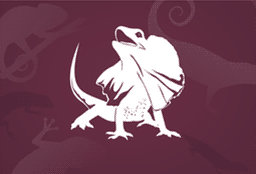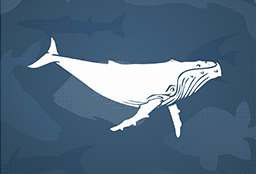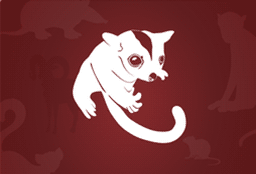Black and white, with the pattern varying across its range. The back of its neck, upper tail and shoulders (on its wings) are white in males and grey in females, and (across most of Australia) the rest of its body is black. In south-eastern, central and south-western Australia, including Tasmania, its back and rump are entirely white. Its eye is red-brown. Young birds are usually grey rather than black and have dark eyes.
Distinctive feature
One toe faces backwards and three face forwards. It has a square-tipped tail.
Grey, grey-brown to olive green body with patches of cream. It has black bands running across its body and tail and a "crest" of spines which start on its head and extend down its back and along its tail. Its belly is creamy-white to creamy brown-grey and the larger, breeding males have a red-orange chest and throat. One of two subspecies also has a broad black stripe running from behind its eye to its ear. It has long, powerful legs and a long, strong tail with flattened sides to assist with swimming. There are loose folds of skin under its jaw.
Juveniles are light brown and their head and feet appear large for their body size.
Size
Around 80 - 90 cm long (nose to end of tail) two-thirds of which is tail. Males are bigger than females.
The caterpillar (larva) is initially a pale yellow-grey, before turning green with long black hairs along its body. Its head is brown-black with short hairs. The female butterfly (adult) is orange with creamy yellow and dark brown patches towards the tip of its forewings (front wings). The male is less colourful, being brown and orange with no pale patches. It also has an obvious raised vein in the middle of its forewing. Both males and females have a small eye-spot on each wing. The undersides of the wings in both the male and female are paler with faint markings, and their hindwings have very few markings. The female’s hindwing is darker then its forewing. It is difficult to identify these butterflies when they are resting with their wings closed. The males emerge quite a while earlier in the year before the females.
Size
Caterpillar about 3.5 cm long; Butterfly wingspan 5.5 – 7.5 cm (females are larger than males).
The top of the adult male's head is grey-black, extending in a line down either side of its white breast. Its throat is also white, with a rufous patch in the centre. Its wings and lower back are dark metallic grey and its upper back and underneath are buff. In flight, its white outer tail feathers are visible. The female has similar but duller colouring. A young bird has less distinct markings with dark olive on top of its head, a white chin and throat and a cinnamon chest and belly.
Distinctive feature
It has a very long, fine beak that curves downward.
It has a grey back and head, and bright-yellow underparts. Southern birds have an olive-yellow rump, while birds in northern Australia have a brighter yellow rump. Its throat is off-white and when seen in flight, it has a pale bar on its wings. Its bill is black. Young birds are rufous-brown with paler streaks.
Size
13 – 17 cm long, the males are slightly larger
Grey-brown to bronze, with a dark stripe running along each side of its body from its nostril, across its eye to its tail, getting wider from its front legs. Its body pales below the stripe to a cream belly.
This species has a lighter body with a less obvious stripe running along its sides than the Southern Garden Skink.
Size
8 - 10 cm (nose to end of tail).
Grey-brown to bronze, with a dark stripe running along each side of its body from its nostril, across its eye to its tail, getting wider from its front legs. Its body pales below the stripe to a cream belly.
This species has a ‘heavier’ looking body and a more obvious stripe running along its sides, compared to the Northern Garden Skink.
Size
8 - 10 cm (nose to end of tail).
The adult male has a bright-yellow underbody, olive-green back and wings, and a black head with a bright-yellow collar. Its throat is white, with a broad black band which separates it from the yellow breast. Its beak and legs are black. The adult female has grey upperparts with a pale olive tinge, and is pale grey below with a pale yellowish tinge. Its beak is dark brown and its legs are grey-brown. Both sexes have a red-brown eye. Juvenile birds are rufous above and below, and as they mature, gradually resemble a female, though they retain some rufous feathers in their wings.
Its head and upperparts are mostly dark grey, with a white eyebrow and throat, a narrow grey band across the upper breast and a creamy-buff belly. The feathers of its long tail have white edges and tips, and the tail is often fanned out.
Size
14 – 16 cm long
Giant tussock-like, rosette plant. Grows up to 2.5 m high with a flower stalk up to 5 m high!
Its genus name Doryanthes (meaning spear and flower), and its species name excelsa (meaning high), both refer to its tall flower stem.
Leaves
Long, sword-shaped and forming a clump. Each individual leaf is 1 – 2.5 m long and about 10 cm wide. Shorter leaves up to 30 cm long are found along the flower stem.
Flowers
Located at the top of a single flower stem which grows from the centre of the tussock of leaves. The stem is 2 – 5 m high upon which the flowers form a cluster up to 70 cm in diameter. The individual flowers are bright red (or rarely white), trumpet-shaped and 10 – 16 cm long.
A black and white bird, the pattern varies slightly between sexes. The male has a white eyebrow above a black horizontal eye-stripe, a black face and throat, while the female has a white face and throat, with a broad vertical stripe through the eye, and no white eyebrow. Both sexes have a thin white bill and black legs and feet. Juvenile Magpie-larks have a black forehead, white eyebrow and a white throat.
They have a transparent mushroom-shaped bell. Its reproductive organs form a conspicuous clover-like shape when viewed from above. Numerous fine thread-like tentacles hang from beneath the edge of the bell.
The moon jelly is a favourite food of marine turtles.
Its genus name Ceratopetalum means horned-petal after one of the species that has petals resembling stag’s horns, and its species name gummiferum means gum-bearing after the gum that oozes out of its bark.
Evergreen shrub or small tree, up to 10 m high and 6 m wide, but much smaller when grown in gardens where it reaches a height of only 2 – 5 m.
Leaves
Glossy green and made up of three leaflets which are 3 – 8 cm long and 0.5 – 3 cm wide when mature. They are thin, with serrated edges, and are a golden orange-red colour when young.
Flowers
Initially creamy white and star-shaped, forming clusters that are 10 cm long. Each flower has five petals that are about 3 mm long. After pollination the white petals fall off, leaving the outer sepals which enlarge to about 12 mm long and turn deep pink to orange-red. These “flowers” consist of five sepals and are also star-shaped. They are commonly mistaken for flowers, but the real flowers are the less noticeable white ones.
A large jellyfish with a rounded bell shape that is clear or tinted brown or yellow. The bell has many obvious small white crystalline spots close to the surface that are evenly distributed.
The tentacles are located in the centre of the bell, with 8 individual arms visible. Two sets of tentacles are visible: one is short, fleshy (cauliflower-like) and the other is longer, clear to white (rope-like) and extend beyond the shorter fleshy tentacles. The longer tentacles also have white spots on their ends.
Grey soft fur, with a white belly and a black stripe that runs from its nose, over its head and along its back. It has a long bushy tail, the last quarter of which is black, often with a white tip. Its ears are large and hairless, and its large eyes are black.
Size
About 28 cm long (from nose to tip of tail).
Metallic blue-black on top and light to dark grey on its breast and belly. Its forehead, throat and upper breast are rust in colour. It has grey legs and feet, and its eyes and bill are black. A young Welcome Swallow has shorter tail feathers than an adult and its forehead and throat are a creamy beige (instead of rust).
Distinctive feature
A deeply forked tail with a white band or row of spots on the long tail feathers.
A large bird of prey with a dark grey back and a white head, white chest and white belly. Their legs are also white and have long black talons. They have dark eyes and a light-coloured, hooked beak. When viewed in flight, the undersides of the wings are a distinctive half white and half grey-brown.
First-year juveniles have a buffish and ‘spiky’ head, contrasting with patchy cream and dark brown body and wings; underwing pattern also patchy, but note half-moon at base of tail feathers. Older juveniles have a pale buff-grey tail.
Their nests are massive, made of sticks and branches, usually found in a tall living tree near water or on a remote coastal cliff (on ground if on an island).
Distinctive feature
A wedge-shaped tail, distinctive when seen in flight.
A medium-sized black and white honeyeater. It has large bright yellow tail and wing panels, with a large conspicuous white cheek patch on a mainly black head. Young birds are duller with brownish plumage.
Size
16-18 cm
Dark grey-brown above with some brown streaking. It is paler below with lighter streaks and has a slightly down-curved bill. Young birds are paler.
Distinctive feature
A broad yellow facial stripe across its eye which is bordered with black.






